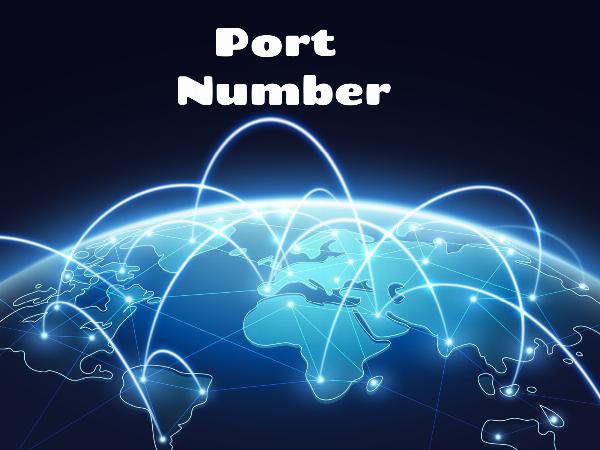What are port numbers, and how do they work?

Strong 8k brings an ultra-HD IPTV experience to your living room and your pocket.
Think of the internet as a busy city with data packets speeding by. Each communication requires an address in this digital metropolis to arrive smoothly. Port numbers are the unsung heroes driving this flawless traffic movement. These numerical gateways allow computers to communicate, like big colosseum entrances directing people to their seats. Understanding port numbers is like interpreting the cyberworld's complicated map, revealing how data flows efficiently over networks and computers. Grab your cyber compass and join us as we explore the intriguing world of port numbers, where every number tells a story of connectedness and communication in cyberspace.
What does a port number mean?
So that you can understand what the port number means, let's get right to it. When a message from the internet or another network gets to a computer, it can be sent to a certain process by using a port number. Every device that can join a network has standard ports, and each one has its own number. Those numbers are only used for a certain system and its purpose. Most of the time, port 80 is used for Hypertext Transfer Protocol (HTTP) traffic.
The Advanced Research Projects Agency Network's developers came up with the idea of port numbers. The developers are a group of system administrators and software writers who work together informally. When they were first created, port numbers were called socket numbers. They are similar to the Internet Protocol (IP) address class that we use today.
Difference between an IP address and a port number?
Let us look at the port numbers and learn more about IP ports. In an IP network, a machine's IP address is used to find it and figure out where a data packet should go. Port numbers help you find certain programs or services in the computer world.
By giving a gadget on the network an IP address, it can be found. Every gadget that connects to the internet is given a unique IP address. This unique identification information lets devices talk to each other over the internet.
Port numbers are used as part of the naming information to show who is sending and receiving data and which program is running on a device. A port number is made up of 16 bits.
the FileOne technique that can be used to send files over the internet between a client and a remote server is File Transfer Protocol (FTP). For files to be sent, FTP must be turned on on both computers. TCP looks for a port on the local host to send the file using the 16-bit port number integer that is added to the FTP request. The Transmission Control Protocol (TCP) is its name.
The TCP layer will send a request to an FTP server if it comes in on port number 21.
What do these port numbers do?
Okay, now you know what my port is and what other port numbers mean. Let's check out how these port numbers work. The port names tell you how to connect to a network. Both TCP and UDP use an IP address and a set of ports in a TCP/IP network.
These port numbers can be used as extra phone lines. To handle incoming and outgoing connections, a computer can have a main address and a set of port numbers. This is similar to how a corporate phone switchboard can use the primary number and give each employee an extension number.
Behind a router, many apps can connect to the same IP address, just like all workers in the same building can use the same phone number. You need to know a computer's IP address and port number in order to find a certain program.
Ports in Computer Networking
In networking, ports are very important parts that make it possible for devices to talk to each other and share data. When we talk about "ports" in networking, we're talking about the exact points on a network where data can be sent and received. Let's learn more about ports and how important they are to networking.
1. Port numbers and how to identify them:
In networking, each port has a distinct number to identify it. These numbers are called "port numbers." Between 1 and 65,535 are these port numbers, which are needed to tell the difference between the different services or tasks that are running on a device in a network. For instance, web servers frequently use port 80, while secure web contact frequently uses port 443. Devices can correctly find and talk to the service they want on another device by using specific port numbers.
2. Protocols for communication:
Communication methods and ports work hand-in-hand in networking. There is a different network protocol for each port, like UDP (User Datagram Protocol) or TCP (Transmission Control Protocol). Ports are used by different protocols to make sure that data is sent properly based on the rules of the communication. This pairing of protocol and port is very important for the exchange of data in networking.
3. Making two-way data flow easier:
Ports let objects on a network talk to each other in both directions. When one device wants to send data to another, it points the data at the other device's IP address and tells it what port number to use. This mixture makes sure that the data gets to the right service or app on the target device, which makes two-way data flow possible.
4. Security for networks and firewalls:
Ports are very important for keeping a network safe. Firewalls are important for protecting networks from threats and people who shouldn't be able to get in. They can be set up to allow or block data based on specific port numbers. This feature lets network managers decide which services can be accessed from outside the network, which makes the network safer.
5. Adaptability and use:
When it comes to networking, ports aren't just for computer networks. They are also useful in many other situations, such as with Internet of Things (IoT) devices that talk to each other through specific ports and even with online games where ports are necessary to connect multiple players.
What do open and closed ports mean?
The port number used is one of the most important parts of both attack and defense. Ports can be either open or closed. There is an application waiting for new connection requests that goes with open ports rather than with closed ports. You should now know how to look for port numbers.
Find out if ports are open by listening for test messages at each port number. This is called network port scanning. As part of a process called "port scanning," network managers often close ports that aren't needed to figure out how likely it is that someone will break into the network. Port scanners are used to find networks with open ports that hackers could use.
In Windows, the netstat command can be used to see what TCP and UDP links are active.
What are port numbers, and how do you use them?
Even though there are 65,535 port numbers, not all of them are always being used.
The numbers 0 through 1023 are called "restricted port numbers" and are only given to large businesses. Apple QuickTime, Structured Query Language, and Gopher all use some of these limited ports.
For people who want to register a particular port number, the range is from 1024 to 49151. Software companies often sign up for these port numbers. Anyone can access ports from 49152 to 65536, which can be dynamic or private.
There is a pool of given port numbers that can be used to give temporary port numbers for the request until it is finished.
What part do ports play in making network connections work better?
Ports in computer networks and the names that go with them make connections between networks much faster. They help network links work better in the following ways:
1. Service Identification: Ports make it possible to pinpoint exactly which service or application data is meant for on a computer network. When port names are included in data packets, devices immediately know which service they are going to. This clears up any confusion and makes sure that data gets to where it needs to go correctly, which increases speed.
2. Multiplexing: Multiplexing is the process of handling more than one network link at the same time. Ports make this possible. A single device can handle multiple services, each with its own port number. With the help of port numbers, the device can easily handle and send data for many services.
3. Easier Routing: Port numbers make it easier for data packets to get to the right place in a network. When routers and switches look at port numbers, they figure out the fastest way for data to get to its location with the least amount of congestion.
4. Network Security: Port numbers are very important for keeping a network safe. You can set up firewalls and other security steps to watch and manage traffic based on certain port numbers. With this level of detail, administrators can let or block data as needed, which makes the network safer and lowers the risk of someone getting in without permission.
5. Easier Troubleshooting: Port numbers are useful for figuring out what's wrong with a network. By looking at traffic on certain ports, network managers can quickly find and fix problems. This targeted method cuts down on downtime and speeds up the resolution process.
6. Scalability: Port addresses make scalability possible in network planning. Since networks can grow and add more services or apps, new port numbers can be given to make room for the growth. This adaptability makes it easy to handle network architectures that change over time.
7. Allocating Resources: Port names help with allocating resources well. There may be different services that need different amounts of energy or bandwidth. Network managers can allocate resources to services based on their needs by using different port numbers. This improves the performance of the network as a whole.
Conclusion
Network communication relies on port numbers to connect devices. Giving each app a unique identification lets numerous apps run on one device. Network managers and developers must understand port numbers to optimize performance and secure communication. Port numbers and their meaning help us comprehend networking protocols and data transmission across networks.
Note: IndiBlogHub features both user-submitted and editorial content. We do not verify third-party contributions. Read our Disclaimer and Privacy Policyfor details.







